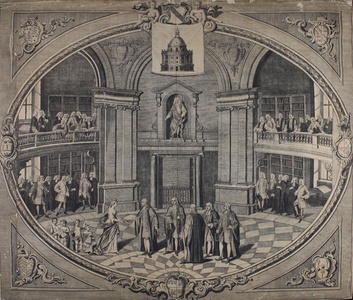| Method | Copper engraving |
| Artist | George Vertue |
| Published | G. Vertue Sculp. [Oxford, 1751] |
| Dimensions | Image 433 x 362 |
| Notes |
An extremely rare example of the topper of the Oxford Almanack for 1751 printed on silk, celebrating the opening of the Radcliffe camera in 1749. The vignette, in an oval baroque frame decorated with escutcheons and cherubs, shows the interior of the famous library. The central figures represent the Trustees, including the Duke of Beaufort and the Earl of Oxford, presenting the keys to a personification of Alma Mater, accompanied by a quartet of cherubs holding attributes of the sciences: Physick, Anatomy, Chemistry, and Biology. This plate was the final almanac to be engraved by George Vertue. Silk-printed examples are uncommon, though there is another on silk in the collections of the British Museum. George Vertue (1684-1756) was an antiquary and engraver. He was born in the parish of St. Martin-in-the-Fields, London. Vertue was apprenticed to a silver engraver and later to the Flemish engraver Michael Vandergucht. His early work includes plates after Kneller, whose academy he attended from 1711. Vertue had a deep interest in antiquarian research, and much of his work was devoted to this subject. He also served as the official engraver to the Society of Antiquaries (1717-56). From 1713 onwards, Vertue dedicated his research to the details of the history of British art, which resulted in an extensive collection of notebooks now in the British Library. The contents of which were the basis of Horace Walpole's 1762 'Anecdotes of Painting'. There are approximately five hundred portraits attributed to Vertue, and an equivalent number of published plates which were devoted to antiquarian subjects. Petter, Helen Mary, The Oxford Almanacks. Oxford. At the Clarendon Press. 1974. p66 Condition: Trimmed to image with loss of calendar. Some surface abrasion, splitting, and chipping. Laid to an album page. |
| Framing | unmounted |
| Price | £500.00 |
| Stock ID | 2909 |

